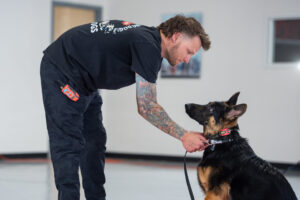One of the most aggravating issues that dog owners confront on walks is leash pulling. It not only makes the walk uncomfortable and stressful, but it can also damage your relationship with your pet. You can, however, teach your dog to walk gently on a leash with the appropriate information and practices.
This post will offer expert advice and techniques to stop your dog from pulling on the leash. We will cover all the key parts of leash training, from understanding the root reasons for leash pulling to selecting the correct equipment, perfecting loose leash walking, and fixing frequent concerns. So, get ready to turn your walks with your dog into pleasurable and calm ones!
Understanding the Root Causes of Leash Pulling
Excitement, curiosity, fear, or even a strong urge to chase squirrels (we can’t blame them, those animals are sly!) are all common reasons for leash pulling. Recognizing these triggers can assist you in addressing the underlying reason for your dog’s pulling.
Dogs, like humans, have distinct personalities, and some breeds have distinct preferences when it comes to leash manners. A Siberian Husky, for example, may have a natural proclivity to pull because of their history of dragging sleds. Understanding your dog’s breed inclinations will help you understand why they are more likely to pull on the leash.
How to Stop Your Dog from Pulling on the Leash
1. Choosing the Right Equipment for Leash Training
Understanding different types of dog harnesses and collars
Harnesses and collars come in a variety of styles, each with its own set of advantages and disadvantages.
Back-clip and front-clip harnesses will promote pulling due to where and how the harness goes around the dog’s body. Collars, on the other hand, come in a variety of forms, including martingale and slip collars, which can provide additional control.
Selecting appropriate leash lengths and materials
The length and material of your dog’s leash might also influence his pulling habit. A longer leash gives your dog more freedom to explore without feeling constrained, whilst a shorter leash gives you more control in tight settings.
In terms of materials, nylon and leather leashes are popular options, but keep in mind your dog’s size, strength, and disposition. A strong and determined puller may want a heavier-duty material to withstand their zeal.
We love 4-foot biothane leashes. They are the perfect length to keep your dog close and easy to clean!
2. Teaching your dog proper leash manners
It is critical to teach your dog proper leash manners to go on delightful walks.
Teach your dog the Heel command so they can learn to walk nicely at your side. Patience and consistency are essential. Remember that Rome was not built in a day, and neither will your dog’s leash etiquette.

3. Establishing a strong foundation with leash commands
When you have a well-trained dog, you have a repertory of leash commands. Using commands like “heel,” “leave it,” and “stay” to create a strong foundation will assist in refocusing your dog’s attention and keep them focused on you.
Practice these commands in a variety of settings, progressively increasing distractions. Your dog will soon master leash etiquette, making walks a breeze.
4. Reinforcement methods for leash training
Finding a leash and collar that can provide reinforcement is the golden ticket to successful leash training. Rewarding your dog for good leash etiquette with food, praise, or even a belly massage gives the message that pulling does not pay off, but walking properly does. Using something like a slip collar or leash that can provide slight pressure when the dog wants to pull ahead of you can be helpful while teaching your dog to walk nicely on a leash
Remember to be liberal with your praise and prizes, and to reinforce favorable behaviors consistently. Instead of acting as your sled dog, your dog will be more inclined to walk beside you.
5. Establishing a consistent leash training routine
The core of successful leash training is consistency. Dogs thrive on routine, so set a regular plan for walks and adhere to it. Each time you leash your dog, use the same orders and approaches. By establishing a schedule, your dog will learn what is expected of them, making the training process more efficient and effective. So put on your sneakers and get ready for some leash action!
6. Consistency and Patience: Key Elements for Success.
Leash training can be difficult, especially if your dog appears to be motivated to drag you down the street like a sled dog. But losing your cool will not benefit you or your pet. During training sessions, be patient and have a cool manner. Dogs catch up on our energy, so they’ll sense it if you’re anxious or frustrated. Take a deep breath, find your zen, and remember that you and your pet are a team even on the most difficult days. You can defeat the leash-pulling struggle if you work together!

Once your dog has mastered the fundamentals of leash training, it’s critical to keep reinforcing good habits to guarantee long-term success. Practice leash walking techniques regularly and incorporate them into your everyday routine. Maintain constant expectations and reward your dog for walking politely on the leash. Remember that repetition makes perfect, so keep with the positive reinforcement!
7. Teaching a Release Command
Just as it’s important to teach dogs to walk nicely on a leash, it’s equally important that they can get a break to sniff, go potty, and enjoy their walk. Teaching a release command such as “break” or “free” is essential for dogs. We cannot expect our dog to heel for an entire 30-minute walk. Giving them their release command after they heel for a couple of minutes allows them to be a dog and enjoy their walk. During your walk, you will rotate between your dog being in a Heel and walking nicely to being on their “break.”
CONCLUSION
Leash pulling is a typical dog trait that can be corrected with proper training and tactics. You may educate your dog to walk gently on a leash by recognizing the underlying causes, selecting the appropriate equipment, and constantly practicing successful training methods. It may take time and effort, but the result will be worthwhile. Maintaining excellent leash walking behaviors and reinforcing training ideas in many contexts can ensure long-term success. Put these expert ideas to use and you’ll be able to enjoy nice walks with your well-behaved and happy dog!
More dog training blogs:
Understanding the Use of Prong Collar in Dog Training
7 Signs of a Professional Dog Trainer Near Me That You Can Trust
